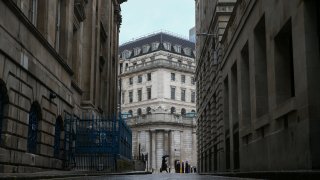
- The central bank's Monetary Policy Committee voted unanimously to keep the main lending rate at a historic low of 0.1%.
- A majority of the committee voted to maintain asset purchases at the current level of £895 billion ($1.24 trillion).
- The pound initially fell by more than 0.5% against the dollar, slipping below the $1.39 mark having tested $1.40 in the previous session. However, it recovered some of the losses to trade at $1.3920 around two hours after the decision.
Sterling retreated on Thursday after the Bank of England kept its monetary policy unchanged, but vowed to monitor rising inflation as the U.K. economy emerges from its Covid-induced slump.
The central bank's Monetary Policy Committee voted unanimously to keep the main lending rate at a historic low of 0.1%, and a majority voted to maintain asset purchases at the current level of £895 billion ($1.24 trillion).
The pound initially fell by more than 0.5% against the dollar, slipping below the $1.39 mark having tested $1.40 in the previous session. However, it recovered some of the losses to trade at $1.3920 around two hours after the decision.
Get a weekly recap of the latest San Francisco Bay Area housing news. Sign up for NBC Bay Area’s Housing Deconstructed newsletter.
Britain's FTSE 100 stock index, which often moves conversely to the currency, was up by around 0.5%. Economists noted that there was no major hawkish shift despite the mention of inflation risks.
The Bank noted that "developments in global GDP growth have been somewhat stronger than anticipated" since its last report in May. It added that global price pressures have picked up further.
Looking ahead, it stated that the committee expects the economy to experience a temporary period of strong GDP growth and above-target inflation, "after which growth and inflation will fall back."
Money Report
However, it added: "There are two-sided risks around this central path, and it is possible that near-term upward pressure on prices could prove somewhat larger than expected. Taking together the evidence from financial market measures and surveys of households, businesses and professional forecasters, the Committee judges that UK inflation expectations remain well anchored."
Outgoing Bank of England Chief Economist Andy Haldane was the dissenting voice in his final meeting as a member of the MPC. Haldane has previously warned that the "tiger of inflation" is incoming and urged the Bank to cut its quantitative easing by £50 billion at the last meeting in May.
"There were no real signs that it is thinking about tightening policy sooner, a la the Fed. We think policy will be tightened much later than the mid-2022 date the markets have assumed," Paul Dales, chief U.K. economist at Capital Economics, said in a research note.
Hinesh Patel, portfolio manager at Quilter Investors, said the Bank was approaching something of a "sliding doors moment" as it continued to hold a wait-and-see approach.
"By headline measures, there is no longer any need for the levels of quantitative easing that markets have become so addicted to," he said.
"However, with every one in four pounds of public spending coming from borrowing without indirect support from the Bank debt sustainability will be ever-more problematic in the future."
Patel suggested that while headline economic growth looked strong, the Bank was right to hold fire.
"We still need to see the full impact of furlough ending and any structural unemployment that emerges, as well as better understanding transitory vs persistent inflation, before it would be appropriate to act," he added.
Inflation surge
The MPC has not altered its policy settings since Nov. 5, 2020, when it increased its bond purchase target from £745 billion to its current £895 billion, while the 0.1% Bank Rate has remained unchanged since March 2020.
U.K. consumer price inflation came in at 2.1% in May, exceeding forecasts and surpassing the bank's 2% target for the first time in almost two years, while core inflation rose from 1.3% in April to 2% in May.
While the market was not expecting any changes to policy on Thursday, the Bank's view of inflationary pressures and clues about its future tightening schedule were in sharp focus. These CPI figures represented a sharper incline than previously expected by the Bank, according to minutes from the last meeting.
The U.S. Federal Reserve last week surprised the market with a hawkish shift, upping its inflation expectations and bringing forward its rate hike schedule to project two increases in 2023.






